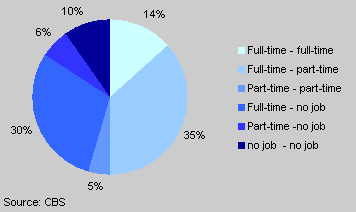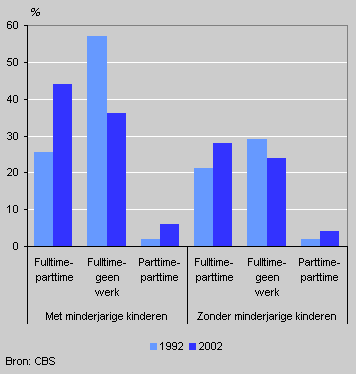Couples increasingly combine full-time and part-time job

In 2002 there were just over 3.5 million couples in the Netherlands. More than half of these were couples in which both partners had a paid job. Most of them combined a full-time and a part-time job.
The proportion of couples consisting of two working partners has risen strongly in the last ten years. In more and more families with under-aged children, in particular, both parents have a job.
Labour participation of couples, 2002

Two jobs for more than half of couples.
In 14 percent of couples, both partners work full-time, and in 36 percent the partners combine a full-time and a part-time job. Five percent had two part-time jobs, both partners working between 12 and 34 hours a week.
Considerably more dual earners
As the labour participation of women has risen strongly in recent years, more and more families have two working parents. The combination of a full-time and a part-time job in particular is becoming increasingly common. The share of couples in which one partner had a full-time job, and the other a part-time job rose from 23 to 36 percent in the period 1992-2002. The share of couples with two full-time workers has remained about the same in the last ten years.
Labour participation of couples, 1992-2002

Proportion of couples with one breadwinner down
The traditional division of roles, where the man earns the money and the woman stays at home to look after the children, is becoming less and less common. In 2002 30 percent of couples consisted of one partner with a full-time job and one with no job. Ten years previously this was the situation for 42 percent of couples.
Labour participation of couples by family situation

Strong growth for families with children
The increase in the full-time/part-time combination was largest for families with under-aged children. In 2002 44 percent of these families had a part-time and a full-time working parent. In 1992 this was still only 26 percent.
Mariëlle Reemers